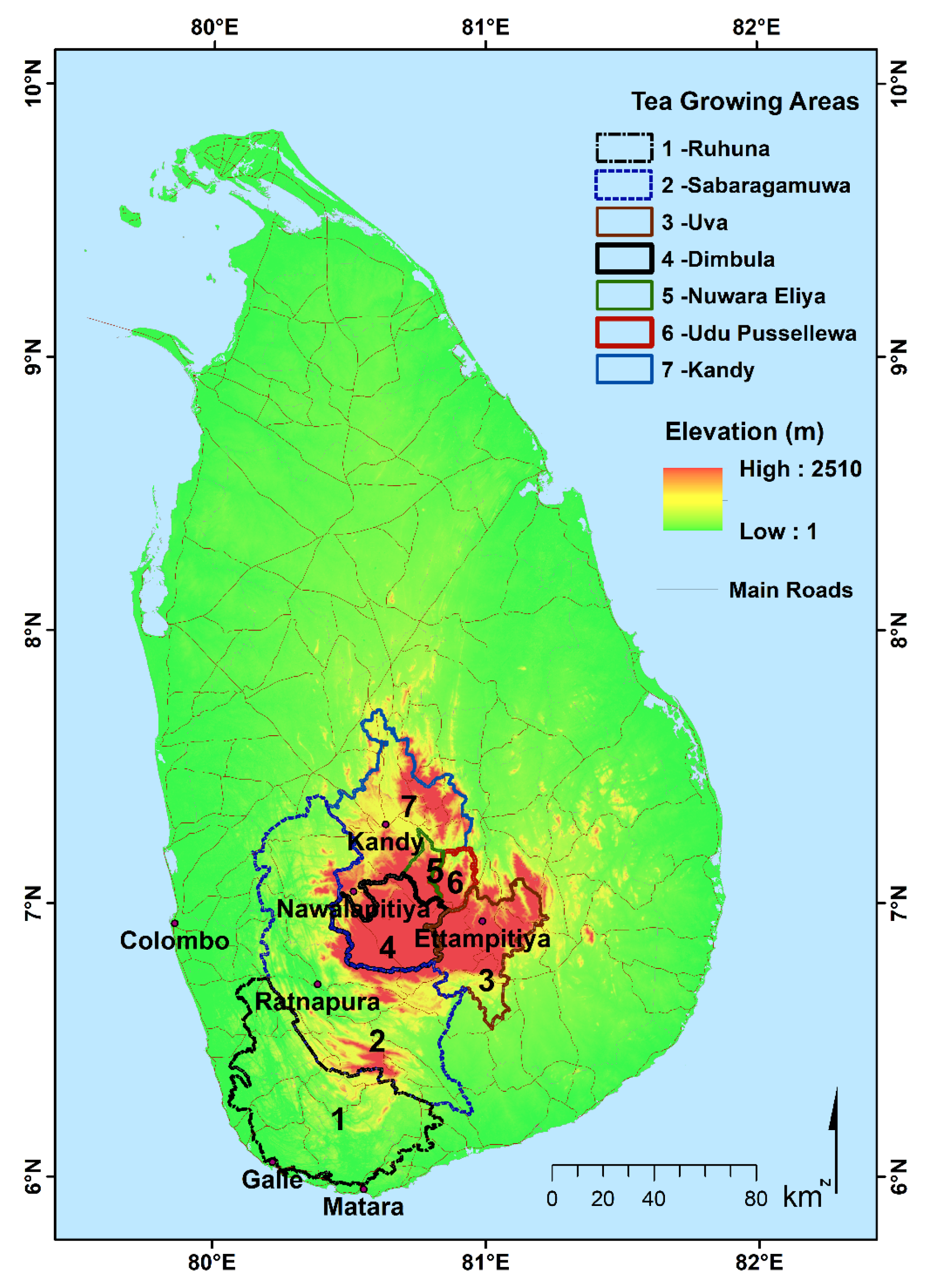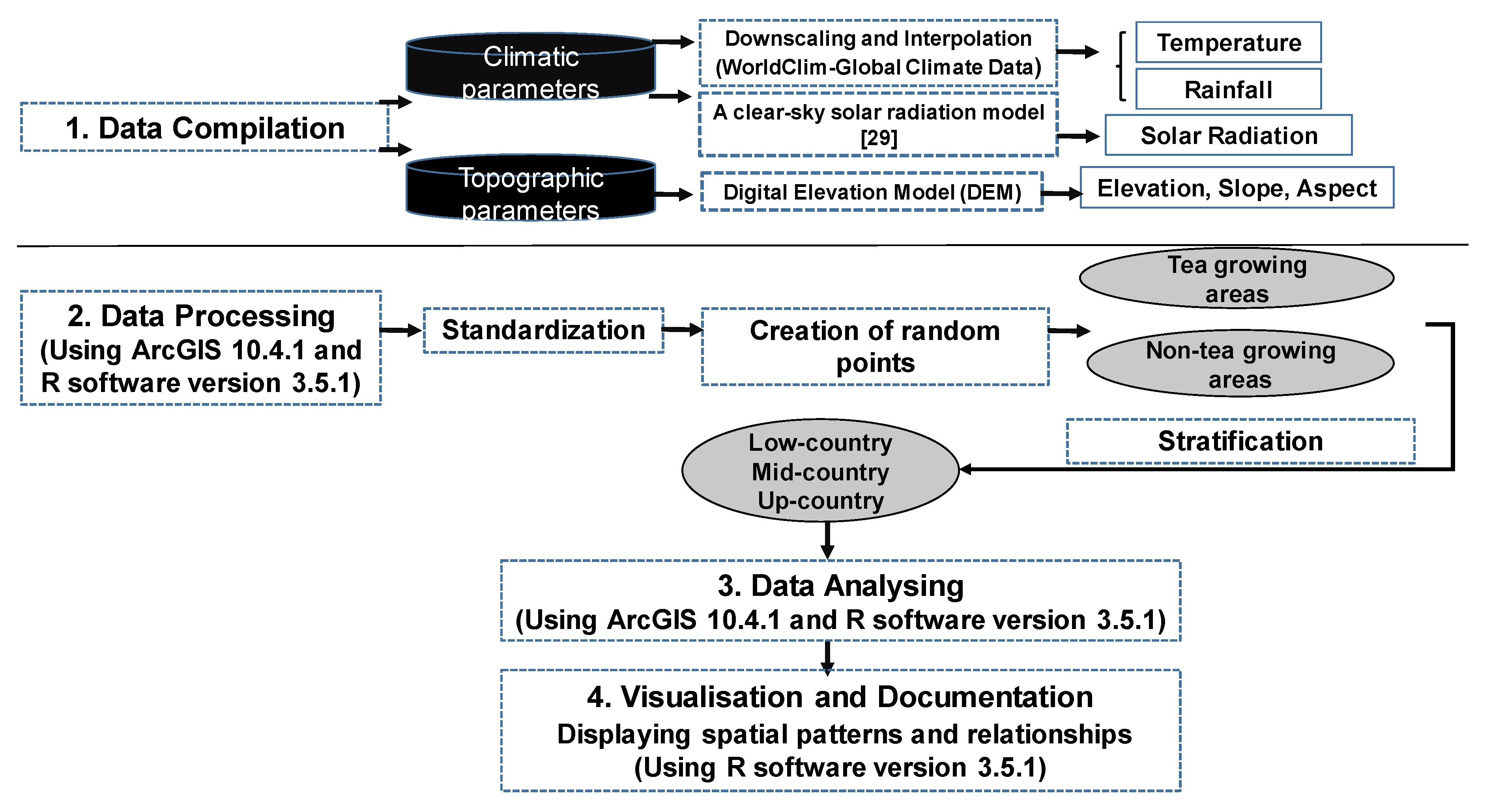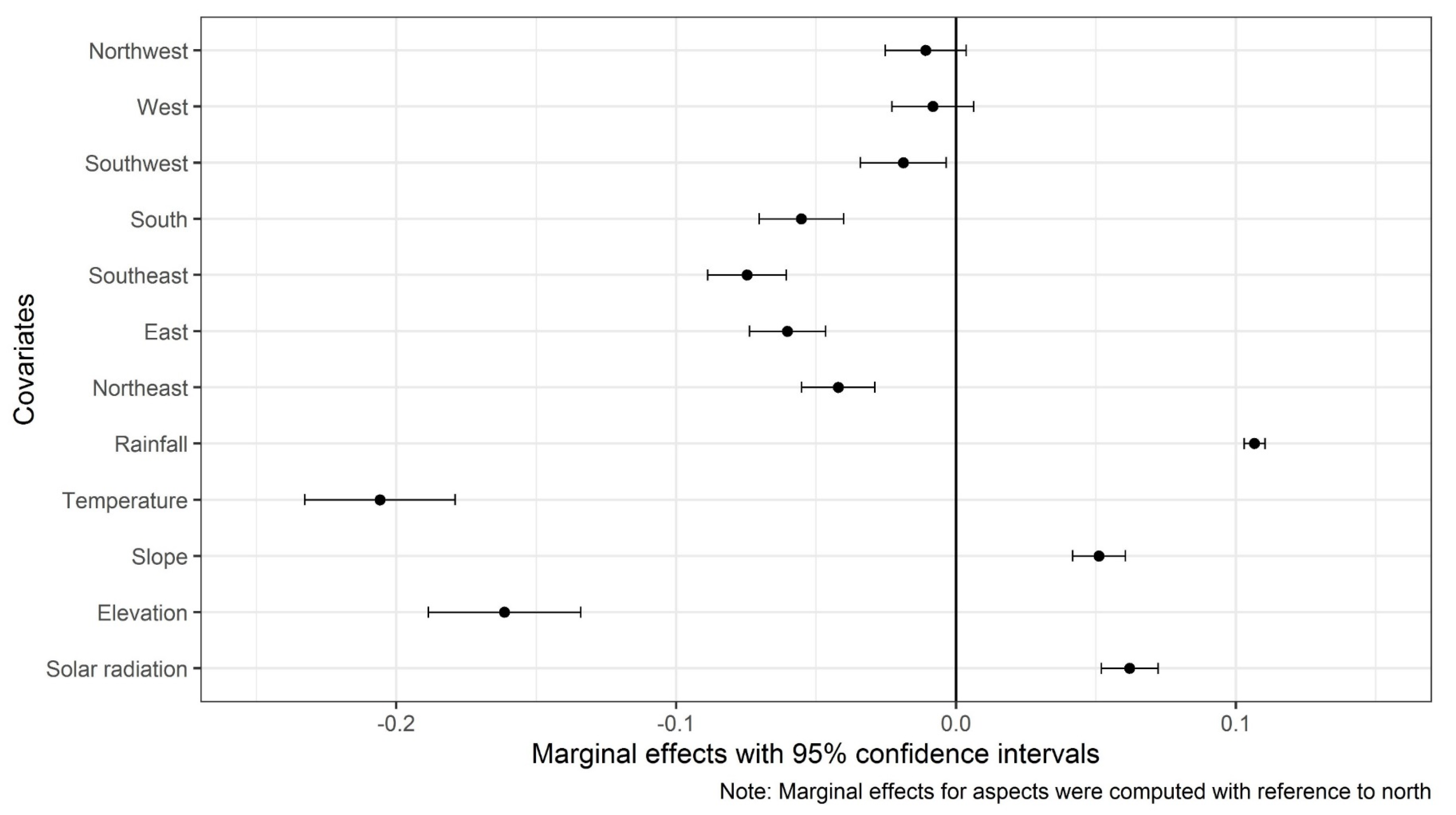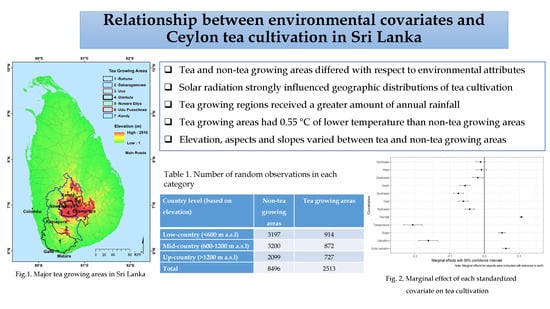Relationship between Environmental Covariates and Ceylon Tea Cultivation in Sri Lanka
Abstract
1. Introduction
1.1. Study Area
1.1.1. Tea Growing Areas
1.1.2. Non-Tea Growing Areas
2. Materials and Methods
2.1. Data Compilation
2.1.1. Solar Radiation
2.1.2. Rainfall and Temperature
2.1.3. Elevation, Slope and Aspect
2.2. Data Processing and Analysis
3. Results
3.1. Climatic and Topographic Covariates Of Tea Cultivation
3.2. Interactions among the Covariates of Tea Cultivation Based on Stratified Data
3.3. Effects of the Covariates on Tea Cultivation
4. Discussion
5. Conclusions
Author Contributions
Funding
Acknowledgments
Conflicts of Interest
References
- Mukhopadhyay, M.; Mondal, T.K. Cultivation, improvement, and environmental impacts of tea. In Oxford Research Encyclopedia of Environmental Science; Oxford University Press: Oxford, UK, 2017. [Google Scholar]
- Gunathilaka, R.D.; Smart, J.C.; Fleming, C.M. The impact of changing climate on perennial crops: The case of tea production in Sri Lanka. Clim. Chang. 2017, 140, 577–592. [Google Scholar] [CrossRef]
- Faostat–Food and Agriculture Organization of the United Nations Statistics Division. Economic and Social Development Department, Rome, Italy. Available online: http://faostat3.fao.org/home/E (accessed on 31 December 2016).
- Esham, M.; Garforth, C. Climate change and agricultural adaptation in Sri Lanka: A review. Clim. Dev. 2013, 5, 66–76. [Google Scholar] [CrossRef]
- Jahfer, A.; Inoue, T. Financial development, foreign direct investment and economic growth in Sri Lanka. Int. J. Econ. Policy Emerg. Econ. 2014, 7, 77–93. [Google Scholar] [CrossRef]
- Hicks, A. Current status and future development of global tea production and tea products. Au Jt 2009, 12, 251–264. [Google Scholar]
- Wijeratne, M. Vulnerability of Sri Lanka tea production to global climate change. Water Air Soil Pollut. 1996, 92, 87–94. [Google Scholar]
- Boehm, R.; Cash, S.; Anderson, B.; Ahmed, S.; Griffin, T.; Robbat, A.; Stepp, J.; Han, W.; Hazel, M.; Orians, C. Association between empirically estimated monsoon dynamics and other weather factors and historical tea yields in China: Results from a yield response model. Climate 2016, 4, 20. [Google Scholar] [CrossRef]
- Chang, K. World tea production and trade: Current and future development. In Food and Agriculture Organization of The United Nations; Market and Policy Analyses of Raw Materials, Horticulture and Tropical (RAMHOT) Products Team: Rome, Italy, 2015. [Google Scholar]
- Brown, A.L.; Lane, J.; Coverly, J.; Stocks, J.; Jackson, S.; Stephen, A.; Bluck, L.; Coward, A.; Hendrickx, H. Effects of dietary supplementation with the green tea polyphenol epigallocatechin-3-gallate on insulin resistance and associated metabolic risk factors: Randomized controlled trial. Br. J. Nutr. 2008, 101, 886–894. [Google Scholar] [CrossRef]
- Pelizzaro-Rocha, K.J.; Veiga-Santos, P.; Lazarin-Bidóia, D.; Ueda-Nakamura, T.; Dias Filho, B.P.; Ximenes, V.F.; Silva, S.O.; Nakamura, C.V. Trypanocidal action of eupomatenoid-5 is related to mitochondrion dysfunction and oxidative damage in Trypanosoma cruzi. Microbes Infect. 2011, 13, 1018–1024. [Google Scholar] [CrossRef]
- Willson, K. Coffee, Cocoa and Tea; CAB International School of Biological Sciences: Wallingford, UK, 1999. [Google Scholar]
- Jayasinghe, H.; Suriyagoda, L.; Karunarathne, A.; Wijeratna, M. Modelling shoot growth and yield of Ceylon tea cultivar TRI-2025 (Camellia sinensis (L.) O. Kuntze). J. Agric. Sci. 2018, 156, 200–214. [Google Scholar] [CrossRef]
- Mohotti, A. Shade in Tea. is it beneficial? Tea Sci. 2004, 69, 27–39. [Google Scholar]
- Carr, M.K.V.; Stephens, W. Climate, weather and the yield of tea. In Tea; Springer: Dordrecht, Germany, 1992; pp. 87–135. [Google Scholar]
- Lemmesa, F. Tea production and management. In Teaching Handout; Department of Plant Sciences, Jimma College of Agriculture: Jimma, Ethiopia, 1996; pp. 1–14. [Google Scholar]
- Burnett, B.N.; Meyer, G.A.; McFadden, L.D. Aspect-related microclimatic influences on slope forms and processes, northeastern Arizona. J. Geophys. Res. Earth Surf. 2008, 113. [Google Scholar] [CrossRef]
- Owuor, P.O.; Obaga, S.O.; Othieno, C.O. The effects of altitude on the chemical composition of black tea. J. Sci. Food Agric. 1990, 50, 9–17. [Google Scholar] [CrossRef]
- Jayasinghe, H.; Kumar, L.; Sandamali, J. Assessment of Potential Land Suitability for Tea (Camellia sinensis (L.) O. Kuntze) in Sri Lanka Using a GIS-Based Multi-Criteria Approach. Agriculture 2019, 9, 148. [Google Scholar] [CrossRef]
- Ali, M.; Islam, M.; Saha, N.; Kanan, A.H. Effects of Microclimatic Parameters on Tea Leaf Production in Different Tea Estates in Bangladesh. World J. Agric. Sci. 2014, 10, 134–140. [Google Scholar] [CrossRef]
- Amarasinghe, U.A.; Mutuwatta, L.; Sakthivadivel, R. Water Scarcity Variations Within a Country: A Case Study of Sri Lanka; IWMI: Colombo, Sri Lanka, 1999; Volume 32. [Google Scholar]
- Jayasinghe, S.L.; Kumar, L. Modeling the climate suitability of tea [Camellia sinensis (L.) O. Kuntze] in Sri Lanka in response to current and future climate change scenarios. Agric. For. Meteorol. 2019, 272, 102–117. [Google Scholar] [CrossRef]
- Mathenge, P.M. Factors Influencing Sustainability of Small Tea Enterprises In Kenya and Suggested Strategies. Ph.D. Thesis, Dedan Kimathi University of Technology, Nyeri, Kenya, 2015. [Google Scholar]
- Lynch, M. Evolution and extinction in response to environ mental change. Biot. Interact. Glob. Chang. 1993, 49, 234–250. [Google Scholar]
- Onduru, D.; De Jager, A.; Hiller, S.; Van den Bosch, R. Sustainability of smallholder tea production in developing countries: Learning experiences from farmer field schools in Kenya. Int. J. Dev. Sust. 2012, 1, 714–742. [Google Scholar]
- Bandara, S.N. Agronomy of irrigated tea in low elevation growing areas of Sri Lanka. Ph.D. Thesis, The University of Adelaide, Adelaide, Australia, 2012. [Google Scholar]
- Rajapaksha, D.; Waduge, V.; Padilla-Alvarez, R.; Kalpage, M.; Rathnayake, R.; Migliori, A.; Frew, R.; Abeysinghe, S.; Abrahim, A.; Amarakoon, T. XRF to support food traceability studies: Classification of Sri Lankan tea based on their region of origin. X-Ray Spectrom. 2017, 46, 220–224. [Google Scholar] [CrossRef]
- Odum, W.E. Pathways of Energy Flow in a South Florida Estuary; University Miami Sea Grant Technical Bulletin; University of Miami: Miami, FL, USA, 1971; Volume 7, p. 162. [Google Scholar]
- Kumar, L.; Skidmore, A.K.; Knowles, E. Modelling topographic variation in solar radiation in a GIS environment. Int. J. Geogr. Inf. Sci. 1997, 11, 475–497. [Google Scholar] [CrossRef]
- Envionmental Growth Chambers. Lighting Radiation Conversion. Available online: http://www.egc.com/useful_info_lighting.php (accessed on 20 June 2019).
- Monteith, J.; Unsworth, M. Principles of Environmental Physics; Edward Arnold: London, UK, 1990. [Google Scholar]
- Campbell, G.S.; Norman, J.M. Radiation fluxes in natural environments. In An Introduction to Environmental Biophysics; Springer: Berlin, Germany, 1998; pp. 167–184. [Google Scholar]
- WorldClim-Global Climate Data–Registry of Research Data Repositories. Available online: http://re3data.org/repository/r3d100011791 (accessed on 27 February 2020).
- Rosenzweig, M.L. Species Diversity in Space and Time; Cambridge University Press: Cambridge, UK, 1995. [Google Scholar]
- Hijmans, R.; Cameron, S.; Parra, J.; Jones, P.; Jarvis, A.; Richardson, K. WorldClim, Version 1.3.; University of California: Berkeley, CA, USA, 2005. [Google Scholar]
- Global Multi-resolution Terrain Elevation Data (GMTED2010). Available online: https://www.usgs.gov/centers/eros/science/usgs-eros-archive-digital-elevation-global-multi-resolution-terrain-elevation?qt-science_center_objects=0#qt-science_center_objects (accessed on 15 December 2019).
- Wickham, H. The Tidyverse. R Package Version 1.2.1. 2017. Available online: https://CRAN.R-project.org/package=tidyverse (accessed on 15 September 2019).
- R Core Team. R: A Language and Environment for Statistical Computing, version 3.3.1.; R Foundation for Statistical Computing: Vienna, Austria, 2016. [Google Scholar]
- Zwick, R. Pairwise comparison procedures for one-way analysis of variance designs. In A Handbook for Data Analysis in the Behavioral Sciences: Statistical Issues; Lawrence Erlbaum Associates: New Jersey, NJ, USA, 1993; pp. 43–71. [Google Scholar]
- Smith, B.G.; Stephens, W.; Burgess, P.J.; Carr, M. Effects of light, temperature, irrigation and fertilizer on photosynthetic rate in tea (Camellia sinensis). Exp. Agric. 1993, 29, 291–306. [Google Scholar] [CrossRef]
- Baker, N.R.; Bowyer, J.R. Photoinhibition of Photosynthesis: From Molecular Mechanisms to the Field; Bios Scientific Publishers: Amsterdam, The Netherlands, 1994. [Google Scholar]
- Renné, D.; George, R.; Marion, B.; Heimiller, D.; Gueymard, C. Solar Resource Assessment for Sri Lanka and Maldives; National Renewable Energy Lab. (NREL): Golden, CO, USA, 2003. [Google Scholar]
- Komaki, S.; Matsuo, K.; Hirose, D.; Tatsumi, J. Analysis of canopy photosynthesis in mature tea (Camellia sinensis L.) bush at late autumn. Jap. J. Crop Sci. 1995, 64, 310–316. [Google Scholar]
- Punyawardena, B.; Kulasiri, D. Stochastic Simulation of Solar Radiation from Sunshine Duration in Sri Lanka; Centre for Computing and Biometrics: Canterbury, New Zealand, 1996. [Google Scholar]
- Nijamdeen, A.; Zubair, L.; Dharmadasa, M.; Najimuddin, N.; Malge, C. Seasonal impact of climate on tea production in Sri Lanka. In National Science and Technology Commission, Centre for Science and Technology of the Non-Aligned and Other Developing Countries (NAM S&T Centre), Tropical Climate; Mahaweli Authority: Rajawella, Sri Lanka, 2017. [Google Scholar]
- Squire, G.R. Seasonal changes in photosynthesis of tea (Camellia sinensis L.). J. Appl. Ecol. 1977, 14, 303–316. [Google Scholar] [CrossRef]
- De Costa, W.A.; Mohotti, A.J.; Wijeratne, M.A. Ecophysiology of tea. Braz. J. Plant Physiol. 2007, 19, 299–332. [Google Scholar] [CrossRef]
- Galmés, J.; Medrano, H.; Flexas, J. Photosynthetic limitations in response to water stress and recovery in Mediterranean plants with different growth forms. N. Phytol. 2007, 175, 81–93. [Google Scholar] [CrossRef] [PubMed]
- TRI. Advisory Circulars. In Guidelines on Land Suitability Classification for Tea; Tea Research Institute of Sri Lanka: Talawakelle, Sri Lanka, 2002; pp. 1–3. [Google Scholar]
- DOM. Climate of Sri Lanka. Available online: http://www.meteo.gov.lk/index.php?option=com_content&view=article&id=94&Itemid=310&lang=en (accessed on 10 November 2019).
- Wijeratne, M.; Anandacoomaraswamy, A.; Amarathunga, M.; Ratnasiri, J.; Basnayake, B.; Kalra, N. Assessment of impact of climate change on productivity of tea (Camellia sinensis L.) plantations in Sri Lanka. J. Natl. Sci. Found. Sri Lanka 2007, 35, 119–126. [Google Scholar] [CrossRef]
- Ahmed, S.; Orians, C.M.; Griffin, T.S.; Buckley, S.; Unachukwu, U.; Stratton, A.E.; Kennelly, E.J. Effects of water availability and pest pressures on tea (Camellia sinensis) growth and functional quality. AOB Plants 2014, 6, 1–9. [Google Scholar] [CrossRef]
- Watson, M. Climatic Requirements and Soil; Tea Research Institute of Sri Lanka: Talawakelle, Sri Lanka, 2008. [Google Scholar]
- Abeysinghe, S.B. 228th Experiments & Extension Forum Keynote Address; Tea Research Institute of Sri Lanka: Talawakelle, Sri Lanka, 2014. [Google Scholar]
- Khormali, F.; Ayoubi, S.; Kananro Foomani, F.; Fatemi, A. Tea yield and soil properties as affected by slope position and aspect in Lahijan area, Iran. Int. J. Plant Prod. 2012, 1, 99–111. [Google Scholar]
- Charizopoulos, N.; Psilovikos, A. Geomorphological analysis of Scopia catchment (Central Greece), using DEM data and GIS. Fresen Environ. Bull 2015, 24, 3973–3983. [Google Scholar]
- Kumar, L.; Skidmore, A.K. Radiation-vegetation relationships in a Eucalyptus forest. Photogramm. Eng. Remote Sens. 2000, 66, 193–204. [Google Scholar]
- Barbour, M.; Burk, J.; Pitts, W.; Gilliam, F.; Schwart, M. Terrestrial Plant Ecology, 3rd ed.Benjamin Cummings: Menlo Park, CA, USA, 1999. [Google Scholar]
- Covey, A. Effects of Elevation on Tea Quality; Red Blossom Tea Company: San Francisco, CA, USA, 2017; Available online: https://redblossomtea.com/blogs/red-blossom-blog/effects-of-elevation-on-tea-quality (accessed on 2 March 2020).
- UTRF. Soil and Nutrition. Available online: http://www.upasitearesearch.org/ (accessed on 20 October 2019).
- Gahlod, N.; Binjola, S.; Ravi, R.; Arya, V. Land-site suitability evaluation for tea, cardamom and rubber using Geo-spatial technology in Wayanad district, Kerala. J. Appl. Nat. Sci. 2017, 9, 1440–1447. [Google Scholar] [CrossRef]
- Li, S.; Li, H.; Yang, C.; Wang, Y.; Xue, H.; Niu, Y. Rates of soil acidification in tea plantations and possible causes. Agric. Ecosyst. Environ. 2016, 233, 60–66. [Google Scholar] [CrossRef]






| Environmental Covariates | Unit | Data Source | Structure of Data |
|---|---|---|---|
| Solar radiation | MJ m−2 day−1 | A clear-sky solar radiation model [29] | Numerical continuous |
| Temperature | °C | WorldClim-Global Climate Data | Numerical continuous |
| Rainfall | Mm | Numerical continuous | |
| Elevation | M | Global multi-resolution terrain elevation data | Numerical continuous |
| Slope | ° | Numerical continuous | |
| Aspect | Unit less | Categorical nominal |
| Country Level (Based on Elevation) | Non-Tea Growing Areas | Tea Growing Areas |
|---|---|---|
| Low-country (<600 m a.s.l) | 3197 | 914 |
| Mid-country (600–1200 m a.s.l) | 3200 | 872 |
| Up-country (>1200 m a.s.l) | 2099 | 727 |
| Total | 8496 | 2513 |
| Covariates | Areas | Min | Max | Mean | SD | t-Statistics |
|---|---|---|---|---|---|---|
| Total solar radiation (MJ m−2 day−1) | Tea growing | 17.05 | 25.51 | 24.51 | 1.00 | 3.90 *** |
| Non-tea growing | 16.41 | 25.52 | 24.60 | 1.05 | ||
| Summer solar radiation (MJ m−2 day−1) | Tea growing | 13.77 | 27.54 | 25.27 | 1.73 | 2.60 ** |
| Non-tea growing | 9.70 | 27.54 | 25.37 | 1.77 | ||
| Autumn solar radiation (MJ m−2 day−1) | Tea growing | 13.59 | 26.58 | 24.31 | 1.71 | 2.33 * |
| Non-tea growing | 12.68 | 26.60 | 24.39 | 1.61 | ||
| Winter solar radiation (MJ m−2 day−1) | Tea growing | 8.97 | 27.51 | 22.58 | 2.59 | 1.35 |
| Non-tea growing | 7.79 | 27.55 | 22.65 | 2.39 | ||
| Spring solar radiation (MJ m−2 day−1) | Tea growing | 15.32 | 27.47 | 25.79 | 1.46 | 3.04 ** |
| Non-tea growing | 11.30 | 27.48 | 25.89 | 1.53 | ||
| Elevation (m) | Tea growing | 1 | 2289 | 651.1 | 514.1 | −7.00 *** |
| Non-tea growing | 3 | 2341 | 572.6 | 487.7 | ||
| Slope (°) | Tea growing | 0.16 | 43.85 | 12.03 | 7.63 | −9.23 *** |
| Non-tea growing | 0.00 | 56.30 | 10.27 | 8.62 | ||
| Mean temperature (°C) | Tea growing | 14.1 | 27.3 | 23.42 | 2.87 | 8.41 *** |
| Non-tea growing | 13.7 | 28.1 | 23.96 | 2.87 | ||
| Annual rainfall (mm) | Tea growing | 1544 | 4829 | 2795 | 624.9 | −29.19 *** |
| Non-tea growing | 1020 | 4808 | 2291 | 796.2 |
| Covariates | Regression Coefficients | Standard Error | Odds Ratios |
|---|---|---|---|
| (Intercept) | −0.907 | 2.021 | 0.404 |
| Total Solar Radiation (MJ m−2 day−1) | 0.374 *** | 0.058 | 1.453 |
| Elevation (m) | −0.002 *** | 0.000 | 0.998 |
| Slope (°) | 0.038 *** | 0.007 | 1.039 |
| Mean Temperature (°C) | −0.448 *** | 0.060 | 0.639 |
| Annual Rainfall (mm) | 0.001 *** | 0.000 | 1.000 |
| North-east | −0.281 ** | 0.095 | 0.755 |
| East | −0.415 *** | 0.107 | 0.660 |
| South-east | −0.530 *** | 0.117 | 0.589 |
| South | −0.377 *** | 0.114 | 0.686 |
| South-west | −0.121 | 0.104 | 0.886 |
| West | −0.053 | 0.096 | 0.949 |
| North-west | −0.069 | 0.095 | 0.933 |
© 2020 by the authors. Licensee MDPI, Basel, Switzerland. This article is an open access article distributed under the terms and conditions of the Creative Commons Attribution (CC BY) license (http://creativecommons.org/licenses/by/4.0/).
Share and Cite
Jayasinghe, S.L.; Kumar, L.; Hasan, M.K. Relationship between Environmental Covariates and Ceylon Tea Cultivation in Sri Lanka. Agronomy 2020, 10, 476. https://doi.org/10.3390/agronomy10040476
Jayasinghe SL, Kumar L, Hasan MK. Relationship between Environmental Covariates and Ceylon Tea Cultivation in Sri Lanka. Agronomy. 2020; 10(4):476. https://doi.org/10.3390/agronomy10040476
Chicago/Turabian StyleJayasinghe, Sadeeka Layomi, Lalit Kumar, and Md Kamrul Hasan. 2020. "Relationship between Environmental Covariates and Ceylon Tea Cultivation in Sri Lanka" Agronomy 10, no. 4: 476. https://doi.org/10.3390/agronomy10040476
APA StyleJayasinghe, S. L., Kumar, L., & Hasan, M. K. (2020). Relationship between Environmental Covariates and Ceylon Tea Cultivation in Sri Lanka. Agronomy, 10(4), 476. https://doi.org/10.3390/agronomy10040476






